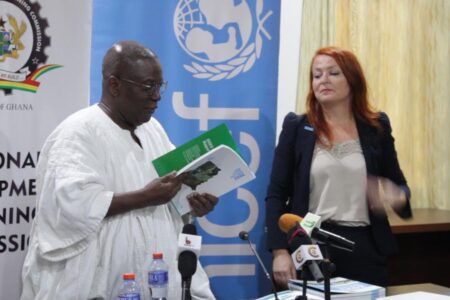The National Development Planning Commission (NDPC), in collaboration with UNICEF, has launched the 2023 District League Table (DLT) report. Since its inception in 2014, the DLT has served as a crucial tool in promoting transparency, accountability, and evidence-based decision-making at both national and subnational levels.
The tool complements NDPC’s mandate of monitoring and evaluating development outcomes across districts in Ghana. Speaking at the launch event at the NDPC offices in Accra, the Chairman of the NDPC, Dr. Nii Moi Thompson, emphasized the importance of focusing on research, including experimental studies, to shape effective development policies.
Dr. Nii Moi highlighted that the DLT is designed to strengthen the national monitoring and evaluation system. It serves as a guide for setting priorities and designing programs that address developmental challenges.
Sunyani Municipal Assembly Tops the 2023 Rankings
During the presentation, Dr. Kwadwo Opoku, a member of the Center for Social Policy Studies at the University of Ghana, revealed that the Sunyani Municipal Assembly emerged as the best-performing district with a score of 94.2% on the 2023 DLT. Ayawaso West Municipality in the Greater Accra Region placed second with 93.9 points, followed by Sekondi-Takoradi Municipal Assembly, which scored 90.2%.
The top 10 performing districts on the 2023 DLT include:
- Sunyani Municipal Assembly – 94.2%
- Ayawaso West Municipality – 93.9%
- Sekondi-Takoradi Municipal Assembly – 90.2%
- Tema Metropolis – 89.8%
- La Dade Kotopon – 89.7%
- Nsawam Adoagyiri Municipal Assembly – 89.6%
- Korle-Klottey Municipality – 89.2%
- Ekumfi District – 89.2%
- Dormaa Central Municipality – 89.0%
Key Findings of the Report
The 2023 DLT ranked all 261 Metropolitan, Municipal, and District Assemblies (MMDAs) based on 18 selected indicators across key sectors such as health, nutrition, education, water, sanitation, energy, child protection, and good governance.
Dr. Opoku explained that the selected indicators were chosen based on their relevance to people’s well-being, availability of reliable data, and their ability to measure tangible outcomes rather than inputs. The report highlighted significant disparities among districts. For instance, in the sanitation sector, while La Dade-Kotopon and Tema West Municipalities scored 100%, East Mamprusi recorded only 12.1%.
On a regional basis, the Greater Accra Region maintained its position as the best-performing region in the DLT. The Eastern, Bono, and Western North regions recorded the highest improvements, reflecting steady growth in development and service delivery. However, the North East Region experienced a decline in both its score and ranking, indicating ongoing developmental challenges that require urgent attention.
Regional Disparities and Sectoral Performance
Despite overall improvements across the country, the three lowest-ranked regions remain in the northern part of Ghana, underscoring the persistent development gap between the northern, middle, and coastal areas.
In terms of access to potable water, 17 districts achieved full coverage, whereas Savelugu Municipality lagged far behind with just 10% coverage. Similarly, the health sector revealed sharp contrasts, with Korle-Klottey Municipality recording nearly 100% in key health indicators while Ablekuma North scored only 28.8%.
Dr. Opoku concluded by stressing that while some regions are making progress, others continue to struggle. He emphasized the need for targeted interventions to ensure balanced national development.
By Madjid Diallo || GhanaNewsOnline

